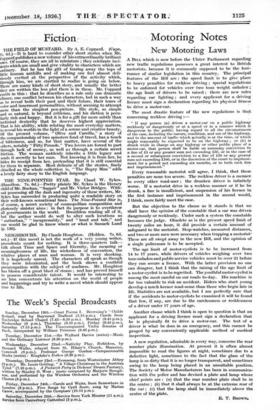- Motoring Notes
New Mototing Laws
A BILL which is now before the Ulster Parliament regardirig new traffic regulations possesses a great interest to British -motorists, because it is commonly supposed to be the fore- runner of similar legislation in this country. The principal features of the Bill are : the speed limit is to give place to heavy penalties for reckless driving ; special regulations to be enforced for vehicles over- two tons weight unladen' ; the age limit of drivers to be raised ; there are new rules regarding car lighting ; and every applicant for a driving licence must sign a declaration regarding his physical fitness to drive a motor-car.
The most drastic feature of the new regulations is that 'concerning reckless driving :-
" If any person (a) drives a motor-car on a public highway -recklessly or dangerously or at a speed or in a manner which is dangerous to the public, having regard to all the circumstances of the case, including the nature, condition, and use of the highway, and to the amount of ttaffic which actually is at the time, or which might reasonably be expected to be on the highway ; or (b) is drunk while in charge on any highway or other public place of a motor-car, that person shall be liable on summary conviction tb a fine of £5 or any greater sum not exceeding £50, or in the case of a second or subsequent conviction to a fine of LIO or any greateir sum not exceeding £100, or in the discretion of the court to imprison- ment for a period not exceeding six months, or to both such flab and imprisonment."
Every reasonable motorist will agree, I think, that these penalties are none too severe. The reckless driver is a menace to every other road-user ; the drunken driver is infinitely worse. If a motorist drive in a reckless manner or if he be drunk, a fine is insufficient, and suspension of his licence in the first instance and imprisonment in the second would, I think, more fairly meet the ease.
But the objection to the clause as it stands is that we -shall have the opinion of the constable that a car was driven dangerously or recklessly. Under such a system the constable becomes the judge. Obsolete as is the present speed limit of twenty miles an hour, it did Provide a Certain amount of safeguard to the motorist. Stop-watches, measured distances, and two or more men were necessary when trapping a motorist. These are all swept away in the new Bill, and the opinion of a single policeman is to be accepted.
The age limit of motor-cyclists is to be increased from 14 to 17 years, while drivers of vehicles weighing over two tons unladen and public service vehicles must be over 21 before they can secure a licence. With the latter provision no one can disagree, but I think that the raising of the age limit of a motor-cyclist is to be regretted. The youthful motor-cyclist is among the most careful on our roads to-day. His machine is far too valuable to risk an accident. Riders who start young develop a much keener road-sense than those who begin late in life. Statistics are not available, but I am perfectly sure that if the accidents to motor-cyclists be examined it will be found that few, if any, are due to the carelessness or recklessness of a driver under 17 years of age.
Another clause which I think is open to question is that an applicant for a driving licence must sign a declaration that
he is physically fit to drive a motor-car. The test of a driver is what he does in an emergency, and this cannot be gauged by any conveniently applicable method of medical inspection.
A new regulation, admirable in every way, concerns the rear number plate illumination. At present it is often almost impossible to read the figures at night, sometimes due to a defective light, sometimes to the fact that the glass of the lamp is so dirty that it is no longer transparent, and sometimes owing to the lamp being placed in an unsuitable position. The Society -of Motor Manufacturers has been in communica- tion with the police and has devised a plate and lamp whose chief points are : (a) that the rear number plate shall be in the centre ; (b) that it shall always be at the extreme rear of E. T. Baows.










































 Previous page
Previous page